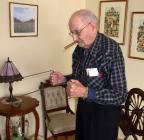2
Dousing in Osgoode TownshipThe former Township of Osgoode (Ward 20, City of Ottawa, as of January 1, 2000) was one of the last areas in Ontario to be surveyed, and subsequently, one of the last regions to be opened for settlement. The survey, completed in 1822, didn't offer much enticement to those army officers, sons and daughters of United Empire Loyalists, and those mainly English, Scottish and Irish immigrants searching for a place to establish their roots. In early records, Osgoode Township was referred to as "impenetrable swamp", much of the land being near perfectly flat, forest covered, and crisscrossed by the three branches of the Castor River. There are many accounts of the extreme hardships encountered while travelling in, and through, the township, and reports also of the lengthy time required to travel short distances. The first visitors to the area followed the "ice roads" provided by the frozen waterways to get to their destinations. Sleighs pulled by oxen, and later horses, were utilized both winter and summer to haul goods across the marshy land, and when the first "roads" were hewn out of the forest, log after log was layered, layer upon layer, across the many soggy areas to enable the passerby to bump across these so called "corduroy" sections of the trail. The Castor River had received its name due to the countless beaver lodges and dams of a very large beaver population that once dotted the river. Even though, by the time of the first settlement in 1827, most of the beaver had disappeared due to the extensive hunting and trapping of the Indians, the Northwest Fur Trade Company and the Hudson Bay Company, large areas of the township was covered in swampy marshes, and it wasn't until the early settlers had cleared the oak and white pine from the banks of the Castor and developed a system of drainage ditches, that farmers were able to till the land and produce their crops.
Needless to say, too much water in the township has been a serious problem in the past, and to this day, drainage remains to be a major concern; however, the lack of a potable water supply to property owners is just as serious. A good supply of safe drinking water for both livestock and human consumption is sometimes difficult to locate. A recent hydrographical study of the area shows a plentiful supply of water situated between fractures and pockets of the layer of shale that in many cases lies close the surface. The study claims the best aquifer is reached by drilling to depth of about 200 to 300 feet. The early wells were "dug" to a depth of 12 to 15 feet. Many wells in the western portion of the township, especially in the area surrounding Osgoode Village and the Prescott Road areas were simply "sand point wells" in which a source of water was obtained by driving a pipe tipped with a"sand point" down into the water-laden, sandy soil to a depth of a few feet. Wells today are drilled, capped and sealed according to government specifications and regulations, and although several of the older wells are shallow, drilled to a depth of only 25 to 30 feet, most today are well over the hundred foot mark.
Many wells have come up "dry", polluted with sulfur, and/or other contaminants, or produced insufficient water quantity (gallons per minute) to be of practical use. Who are you going to call? Why, a water douser of course! Although there have been several dousers, including Osgoode farmer Emerson Irven, now a resident of the Township of Osgoode Care Centre, who have been able to locate water in the township, Metcalfe resident Ray Wilson appears to be the best known and the most successful "water witcher" of the past seven decades or so.
Wilson was born at Halibury, Ontario, on August 26, 1911 . (That makes him 93 years old at the time of this article, and he is still going strong, although his "talent" for dousing for water has given way to dousing for "body ailments".) When gold was discovered in the Yukon, Ray's father. a farmer and prospector headed for the gold fields. (Ray claims his dad never "struck it rich" however, although he remembers his dad carrying a rather large nugget on a gold chain upon his return.) When Ray was two or three years old, he went to live on his grandfather's farm which was situated in Osgoode Township - Lot 25 Concession 10. (Ray's great grandfather, John Wilson, had been an early Osgoode settler, his farm taking up Lot 17 Concession 10). Ray lived, worked, married, and raised his family on his grandfather's farm having retired to the village of Metcalfe in the late 70's.
Ray attended elementary school at York's Corners School and then went on to get his Junior Matriculation at Kenmore Continuation School. Following the acquisition of a Bachelor of Science of Agriculture Degree (BSA) upon the completion of a four-year program at the University of Guelph, Ray returned to his family's farm very eager to try out the newly-acquired farming techniques that he had learned at Guelph., one of which was the importance of drainage. Even though some ditching had been done in the township, according to Ray. there wasn't really much done until the Dutch families settled here in the 1950's. They started to drain their farms much in the same fashion as they had done back in their homeland of Holland where drainage systems had to be established to keep their farms above water.
Ray became interested in dousing in 1929 or 1930, after observing an old lad who was a member of a ditching crew that was digging a drain on their farm. This fellow was using a "divining rod" to track the underground stream of water that had been soaking their fields. Ray asked if he could try his luck using the rods. Much to his amazement, he discovered that he possessed the "power" to locate water. He doused a couple of wells on their own property and as his "fame" spread, he was asked to find the "sweet spots" for many successful digs and/or drilling operations. Ray claims to have accurately doused approximately 300 wells in his lifetime, many of them in Osgoode Township and farther afield in such places as Nova Scotia, Noranda, Quebec, Kingston, Vankleek Hill, Gloucester Township, and Renfrew. In several instances, Ray has been called in when others had failed to locate water after several unsuccessful attempts had been made, or when the supply of water found was not adequate. Ray claims he has always been successful in locating a good source of water. Not only that, he can tell how deep to drill, the amount of flow to be realized, and whether the water is fit to drink. He has a vast collection of written testimonials from "satisfied customers". One of Ray's most successful "hits" was at the Continental Mushroom Farm on the 9th Line Road., just east of Metcalfe. This huge complex consisting of several growing houses was short on the amount of water necessary for the production of the thousands of pounds of mushrooms grown there annually. Ray was called in after several attempts to locate more water had failed. Ray doused the property and came up with three highly likely sites. Wells were drilled and all three were more than adequate for the plant's needs.
4
How does he do it? Ray's "tools" consist of two round steel rods approximately 4 mm in diameter, bent into an "L" shape, The main shaft of each rod is about 35 cm in length and the "handle" about 12 cm long - the handle portion rotates freely in a metal sleeve which Ray grasps in his hands. There is a small 90 degree turn at the base of the handle to keep the sleeve in place. When Ray walks over an underground stream of water. the rods swing in together and cross each other, or they swing outward away from each other. (Ray claims it doesn't matter which way the rods turn. Both indicate that water has been located.).6
In some instances, where a property owner was having difficulty obtaining a sufficient supply of water from an already established well, Ray has doused the property only to discover that the course of the underground stream was not close enough to the well site. By driving a steel stake into the ground above the stream and using a sledge hammer he strikes the stake several times in the direction of the well, and as a result, the stream's course actually shifts and is redirected towards the well thus producing a greater supply of water to the well.8
In a pinch, Ray has successfully used two steel coat hangers with the same effect. He loosely grasps the centre of the bottom portion of each hanger, holding the entire hanger in a vertical position . As he walks over the underground stream, the curved part of the hanger responds by turning inward or outward. Other dousers may use a forked twig, preferably taken from a branch of a fruit tree or a willow in their dousing operation; however, Ray prefers his homemade steel divining rods.10
Lately, Ray's "tool-of-choice" is the plumb bob. Nothing fancy - just a heavy duty steel, hexagonal-shaped nut having a diameter of about 3.5 cm. and suspended from a short piece of ordinary string. Ray holds the string between his index finger and the thumb of his right hand and at a height of about 30 cm above a map, or even above a rough sketch of the property. By concentration, or as Ray calls it "using my brain power", Ray is able to pinpoint the exact location of a well. In a state of deep thought, he asks himself a series of questions and the nut responds by a back and forth, and/or a circular, motion, and answers Ray's questions with a "yes" or a "no". This "distance, or map, dousing" has resulted in the drilling of several successful wells.Ray has used his "educated nut", as some refer to it, for many other purposes. By using his power of concentration and swinging the plumb bob in front of a person's chest , he claims he can tell an individual's I.Q., or the state of his/her physical health. The procedures used in "map dousing" can be used for "mapping" the human body according to many dousers. Instead of following underground steams, the human body can be mapped using meridians, vessels, organs, etc., to provide a "systems check" and to detect possible health problems. . For the last 20 years, Ray has been sought out far and wide for his "healing powers". Does Ray possess such talents? Many "believe" so. Ray always insists, however, that he is not a doctor and that individuals coming to him should always seek professional medical consultation.
12
Often, dousers are called upon to locate something that has been lost. On more than one occasion, Ray has successfully located the burial site of an individual who had been interred in an unmarked grave. In another instance, a person from the London, Ontario area, after hearing stories of Ray's dousing successes, sent Ray detailed topographical maps of an area in Virginia where, supposedly, a vast hoard of gold had been hidden while being transported along a mule train route from Colorado during the days of the California Gold Rush. This "Beihl Treasure", as it is now known, has captured the imaginations of thousands of "treasure seekers" for years ever since a secret code based upon "The Declaration of Independence" was broken which indicated 30 iron pots of gold bullion had been buried for safe keeping. (Another secret code has yet to be broken which would give the exact location of the buried treasure.) Ray plumbed the maps with his pendulum, and gave many details of the existence of the gold , information that was not known to him previously, but, as to the actual whereabouts of the gold, Ray was less promising. According to him, the gold had been found years ago and nothing remained to be "discovered". The treasure seeker from London upon learning of this revelation, doubted Ray's findings and is still on the trail of this missing loot. Perhaps Ray knows best.How does it work? According to Leroy Bull, a director of the 5,000 strong American Society of Dowsers, of which Ray is a member, one explanation is that everything, all matter, consists of energy, and energy emits electromagnetic waves. These waves have frequency. A divining rod enables the person holding it to actually pick up this frequency much like a tuning fork, or any piece of metal if struck and then touched to a wooden table or musical instrument such as a guitar. The wood picks up the frequency and amplifies it. Other less scientific explanations suggest that dousing is a type of divination whereby the douser tries to locate objects by occult means. Some suggest that dousing is a paranormal occurrence such as ESP involving a mental visualization of the unseen. Although Ray believes that the closeness of underground electromagnetic lines may produce "cancer strips", as Ray calls them, he truly believes that some individuals have the "brain power" to "see" what others cannot. Such devices as the divining rod and the plumb bob are tools to verify these "observations". Like the "Buckley Cough Syrup" commercial, it may be hard to understand, but, "It works!"
Ron Isaac,
President,
The Township of Osgoode Historical Society





